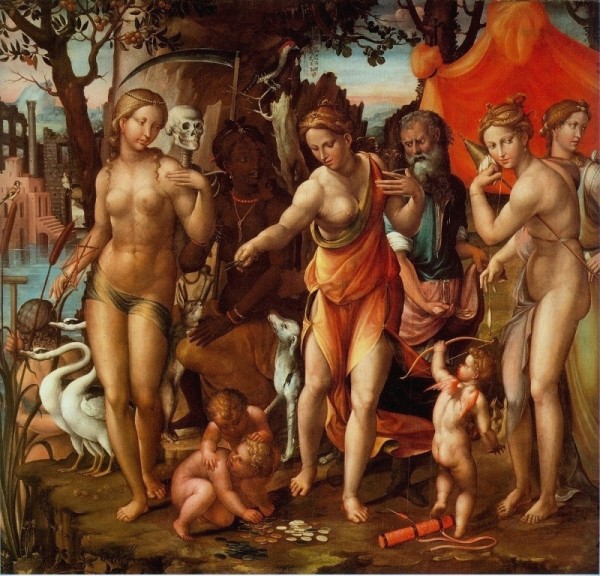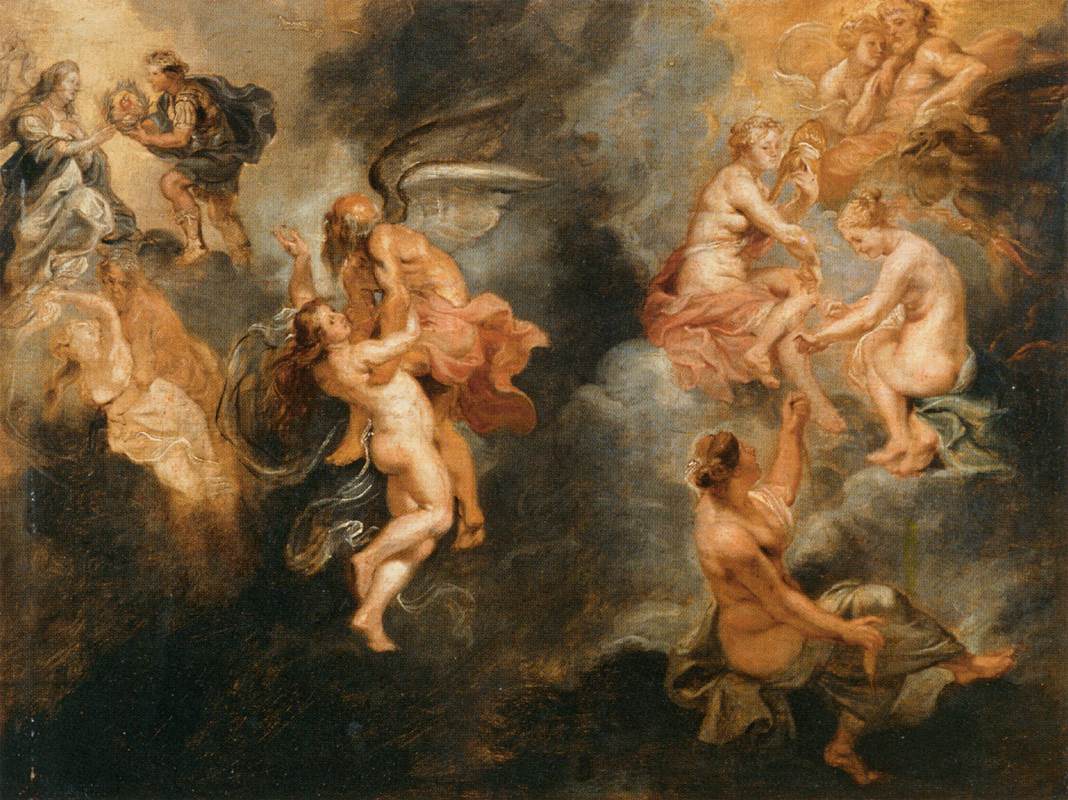Parcae on:
[Wikipedia]
[Google]
[Amazon]


 In
In
 Nona was supposed to determine a person's lifespan on the ''
Nona was supposed to determine a person's lifespan on the ''


 In
In ancient Roman religion
Religion in ancient Rome consisted of varying imperial and provincial religious practices, which were followed both by the people of Rome as well as those who were brought under its rule.
The Romans thought of themselves as highly religious, ...
and myth
Myth is a folklore genre consisting of narratives that play a fundamental role in a society, such as foundational tales or origin myths. Since "myth" is widely used to imply that a story is not objectively true, the identification of a narrat ...
, the Parcae (singular, Parca) were the female personification
Personification occurs when a thing or abstraction is represented as a person, in literature or art, as a type of anthropomorphic metaphor. The type of personification discussed here excludes passing literary effects such as "Shadows hold their ...
s of destiny
Destiny, sometimes referred to as fate (from Latin ''fatum'' "decree, prediction, destiny, fate"), is a predetermined course of events. It may be conceived as a predetermined future, whether in general or of an individual.
Fate
Although often ...
who directed the lives (and deaths) of humans and gods. They are often called the Fates
The Fates are a common motif in European polytheism, most frequently represented as a trio of goddesses. The Fates shape the destiny of each human, often expressed in textile metaphors such as spinning fibers into yarn, or weaving threads o ...
in English, and their Greek equivalent were the Moirai
In ancient Greek religion and mythology, the Moirai (, also spelled Moirae or Mœræ; grc, Μοῖραι, "lots, destinies, apportioners"), often known in English as the Fates ( la, Fata, Fata, -orum (n)=), were the personifications of fat ...
. They did not control a person's actions except when they are born, when they die, and how much they suffer.
Names and history
The Parcae controlled the metaphorical thread of life of every mortal and immortal from birth to death. Even the gods feared them, and by some sourcesJupiter
Jupiter is the fifth planet from the Sun and the largest in the Solar System. It is a gas giant with a mass more than two and a half times that of all the other planets in the Solar System combined, but slightly less than one-thousand ...
was also subject to their power.
The names of the three Parcae are:
* Nona (Greek equivalent ''Clotho
Clotho (; el, Κλωθώ) is a mythological figure. She is the youngest of the Three Fates or Moirai who spins the thread of human life; the other two draw out ( Lachesis) and cut (Atropos) in ancient Greek mythology. Her Roman equivalent is ...
''), who spun the thread of life from her distaff onto her spindle;John Day, ''God's Conflict With the Dragon and the Sea: Echoes of a Canaanite Myth in the Old Testament'', CUP Archive, 1985, p. 308.
* Decima (Greek '' Lachesis''), who measured the thread of life with her rod;
* Morta (Greek ''Atropos
Atropos (; grc, Ἄτροπος "without turn") or Aisa, in Greek mythology, was one of the three Moirai, goddesses of fate and destiny. Her Roman equivalent was Morta.
Atropos was the oldest of the Three Fates, and was known as "the Inf ...
''), who cut the thread of life and chose the manner of a person's death.
The earliest extant documents referencing these deities are three small stelae ''(cippi)'' found near ancient Lavinium
Lavinium was a port city of Latium, to the south of Rome, midway between the Tiber river at Ostia and Antium. The coastline then, as now, was a long strip of beach. Lavinium was on a hill at the southernmost edge of the ''Silva Laurentina'', ...
shortly after World War II
World War II or the Second World War, often abbreviated as WWII or WW2, was a world war that lasted from 1939 to 1945. It involved the World War II by country, vast majority of the world's countries—including all of the great power ...
. They bear the inscription:
''Neuna fata, Neuna dono, Parca Maurtia dono''The names of two of the three Roman Parcae are recorded (''Neuna'' = Nona, ''Maurtia'' = Morta) and connected to the concept of ''fata''.
 Nona was supposed to determine a person's lifespan on the ''
Nona was supposed to determine a person's lifespan on the ''dies lustricus
In ancient Rome the ''dies lustricus'' ("day of lustration" or "purification day") was a traditional naming ceremony in which an infant was purified and given a ''praenomen'' (given name). This occurred on the eighth day for girls and the ninth d ...
'', that is, the day on which the name of the child was chosen, which occurred on the ninth day from birth for a male and the eighth for a female.
The recurrence of the nundinae was also considered a '' dies festus'' and as such '' nefas'' by some Roman scholars as Julius Caesar
Gaius Julius Caesar (; ; 12 July 100 BC – 15 March 44 BC), was a Roman general and statesman. A member of the First Triumvirate, Caesar led the Roman armies in the Gallic Wars before defeating his political rival Pompey in a civil war, an ...
and Cornelius Labeo
Cornelius Labeo was an ancient Roman theologian and antiquarian who wrote on such topics as the Roman calendar and the teachings of Etruscan religion ''(Etrusca disciplina)''. His works survive only in fragments and '' testimonia.''
He has been ...
, because on it the ''flaminica dialis
In ancient Roman religion, the was the high priest of Jupiter. The term ''Dialis'' is related to ''Diespiter'', an Old Latin form of the name ''Jupiter''. There were 15 '' flamines'', of whom three were ''flamines maiores'', serving the thr ...
'' offered the sacrifice of a goat to Jupiter in the Regia.
One of the sources for the Parcae is ''Metamorphoses
The ''Metamorphoses'' ( la, Metamorphōsēs, from grc, μεταμορφώσεις: "Transformations") is a Latin narrative poem from 8 CE by the Roman poet Ovid. It is considered his '' magnum opus''. The poem chronicles the history of the ...
'' by Ovid
Pūblius Ovidius Nāsō (; 20 March 43 BC – 17/18 AD), known in English as Ovid ( ), was a Augustan literature (ancient Rome), Roman poet who lived during the reign of Augustus. He was a contemporary of the older Virgil and Horace, with whom ...
, II 654, V 532, VIII 452, XV 781.
Another source is Aeneid
The ''Aeneid'' ( ; la, Aenē̆is or ) is a Latin epic poem, written by Virgil between 29 and 19 BC, that tells the legendary story of Aeneas, a Trojan who fled the fall of Troy and travelled to Italy, where he became the ancestor of ...
by Virgil
Publius Vergilius Maro (; traditional dates 15 October 7021 September 19 BC), usually called Virgil or Vergil ( ) in English, was an ancient Roman poet of the Augustan period. He composed three of the most famous poems in Latin literature: th ...
, in the opening of Book I.
According to some treatments, the Parcae seem to be more powerful than many, or perhaps even all, of the gods: "The power of the Parcae was great and extensive. Some suppose that they were subjected to none of the gods but Jupiter; while others support that even Jupiter himself was obedient to their commands; and indeed we see the father of the gods, in Homer's Iliad, unwilling to see Patroclus perish, yet obliged, by the superior power of the Fates, to abandon him to his destiny." Similarly: "We have the clearest evidence of the poet for it, that whatever happens to us is under the influence of the Parcae. Jupiter himself can not interfere to save his son Sarpedon."
See also
*Fates
The Fates are a common motif in European polytheism, most frequently represented as a trio of goddesses. The Fates shape the destiny of each human, often expressed in textile metaphors such as spinning fibers into yarn, or weaving threads o ...
* Norns
The Norns ( non, norn , plural: ) are deities in Norse mythology responsible for shaping the course of human destinies.'' Nordisk familjebok'' (1907)
In the '' Völuspá'', the three primary Norns Urðr (Wyrd), Verðandi, and Skuld draw w ...
, equivalent of the Fates in Norse mythology
Norse, Nordic, or Scandinavian mythology is the body of myths belonging to the North Germanic peoples, stemming from Old Norse religion and continuing after the Christianization of Scandinavia, and into the Nordic folklore of the modern per ...
* List of Roman birth and childhood deities
In ancient Roman religion, birth and childhood deities were thought to care for every aspect of conception, pregnancy, childbirth, and child development. Some major deities of Roman religion had a specialized function they contributed to this ...
References
Further reading
* Thomas Blisniewski: ''Kinder der dunkelen Nacht. Die Ikonographie der Parzen vom späten Mittelalter bis zum späten XVIII.'' Jahrhundert. Thesis. Cologne 1992. Berlin 1992External links
* {{Authority control Roman goddesses Time and fate goddesses Triple goddesses Destiny Textiles in folklore